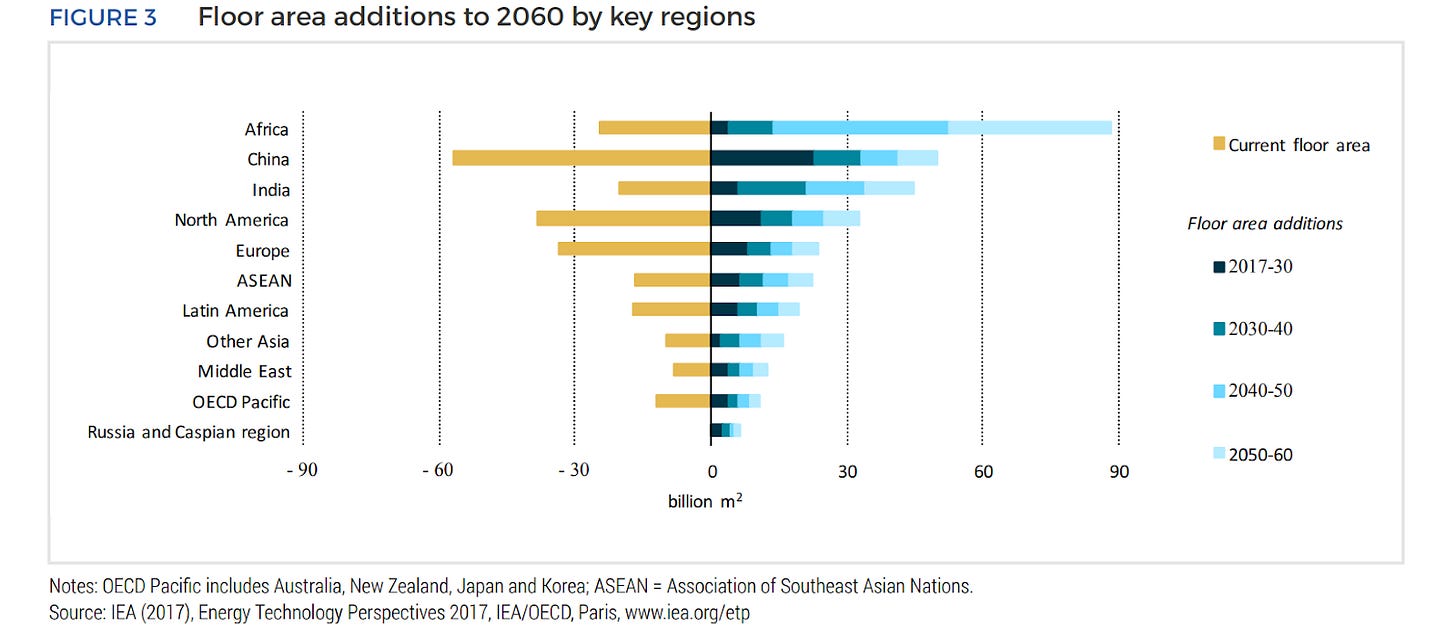Tackling emissions in the building sector
A proposal
To access related resources and notes, visit the Build Incentive Home in Roam
🏢 🏠
Buildings are critical to address climate change and public health.
Rethinking new construction and retrofits for the built environment is critical to meet our collective climate goal-- to limit global warming to 1.5°C above pre-industrial levels, akin to net zero emissions by 2050.
Globally, buildings account for 40% annual global CO2 emissions. Out of total greenhouse gas (GHG) emissions, buildings account for about one-third emissions. And the base is growing. Our global building stock is on track to double its footprint by 2060.
Buildings are also where we spend most of our time. It’s important to think of the “buildings industry” not just as the structures themselves, but as the setting for our day-to-day life. (And our day-to-day emissions.)
In short: Buildings have big impact. With benefit that extends beyond climate to opportunities for improved public health, learning, and collaboration as well.
With their long life cycle— ~100 years— decisions made at the start of a building will continue through the lifetime of the product. Not only are there “embodied” emissions generated during material manufacture and construction, but design decisions made at the start (e.g. site selection, orientation, structure, insulation, etc) place constraints on future emissions as the building continues to operate.
The good news is that there is a lot we can do today. Many of the technologies we need to deploy are already available and in the process of sliding down the cost curve. (And with more deployment comes more lessons learned and thus more chances to reduce cost.)
Availability matters, because it means we can get started now. Given UNEP’s current projections: over two-thirds of global buildings in 2050 are already built, today. In North America, that figure is around 70% if not higher.
We have several options to improve the building sector.
We have many market and policy-driven opportunities to reduce and even remove GHG emissions within the global buildings industry. These solutions fit across three main emission phases of the building lifecycle—Embodied, Operational, End of Life—with options to reduce 🔽 and even remove ⏏️ associated emissions.
We need to tackle all three:
Embodied emissions (~11% global CO2)
Culprit: CO2 from materials that go into buildings, such as steel and cement
Solutions:
Design/Build for simpler upgrades / retrofits to avoid future demolition waste 🔽
Design/Build buildings with less material use 🔽
Develop & Deploy reduced carbon materials (e.g. low-carbon steel or low-carbon cement— or alternative materials like mass timber) 🔽
/⏏️Actively sequester carbon during manufacturing process / in new building materials ⏏️
Example: Opus 12
Example: CarbonCure, Blue Planet
Facilitate transactions for reduction / removal of embodied emissions 🔽
/⏏️Example: Stripe Climate
Operational emissions (~28% global CO2)
Culprit: CO2 from energy to run buildings, whether direct (e.g. CO2 from combusting oil or gas for space heating) or indirect (e.g. CO2 electricity generation or district heating)
Solutions:
Design/Build/Operate buildings for improved operational efficiency 🔽
Rethink buildings as integrated assets
Electrify buildings and make it easier to decarbonize generation & storage, affordably 🔽
Enable microgrid / distributed energy resource transactions
Example: Leap, OhmConnect
Develop & Deploy energy efficient appliances & control systems 🔽
Actively sequester carbon during heating/cooling process ⏏️
Example: Carbon negative district heating
Facilitate transactions for reduction / removal of operational emissions 🔽
/⏏️Example: Patch
End of Life emissions (Much harder to quantify)
Culprit: F-gasses from refrigerants used in air conditioning. Even HFCs, which have largely replaced CFCs & HCFCs, still have 1,000-10,000 greater global warming potential (GWP) than carbon dioxide. Did you know that 90% of refrigerant emissions happen during end of life disposal?
Solutions:
Design/Build/Operate buildings for less additive cooling 🔽
Manage leakages & end of life disposal for existing AC units 🔽
❓I am curious about this field but haven’t come across companies in this space. Do you know of any?
Develop & Deploy new types of ACs that use less F-gas 🔽
Develop & Deploy F-gas alternatives 🔽
❓I am curious about this field but haven’t come across companies in this space. Do you know of any? Especially given the recent American Manufacturing and Innovation (AIM) Act.
Facilitate transactions for reduction / removal of end-of-life emissions 🔽
/⏏️
However, incentives in the building industry are misaligned. Could this “misalignment cost” slow down our climate & public health goals?
Incentives in the building industry are misaligned. This occurs in the dichotomy between construction and operation (Developers & Building Contractors have different incentives than Occupants and Facilities Managers), in the split incentives between Landlords and Tenants (Landlords have different responsibilities / careabouts than Tenants do), and in the temporal distinction between now and 20 / 30 / 50 / 100 years from now.
This landscape is not specific to North America, these same dichotomies exist around the globe. And these challenges don’t just impact climate health— they impact our public and collaborative health, too.
My hypothesis is that this misalignment in the building industry does slow down our global climate, public health, and collaboration goals. But in what ways? And what do we do about it? What policies/programs/products can we enable and build?
This is my journey to answer those questions.
Stay tuned. 工


